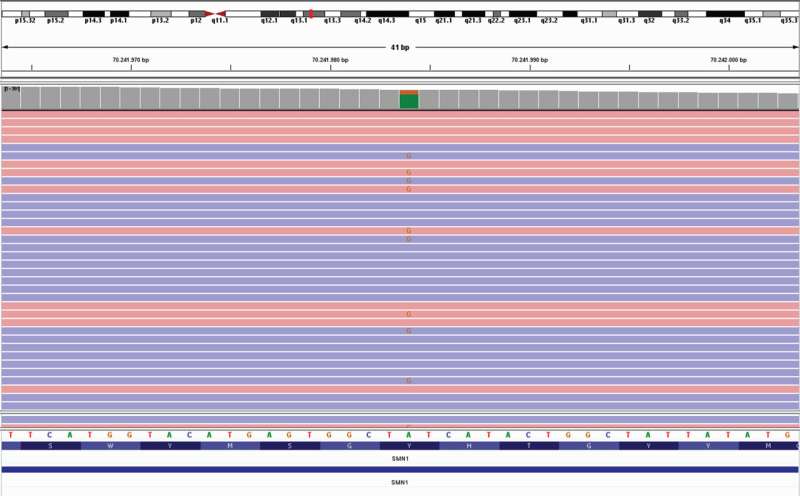This article has been reviewed according to Science X's editorial process and policies. Editors have highlighted the following attributes while ensuring the content's credibility:
fact-checked
trusted source
proofread
Novel workflow closes the gap in detecting 5q-spinal muscular atrophy

The disease 5q-spinal muscular atrophy (5q-SMA) is one of the more common types of spinal muscular atrophy (SMA) affecting around 1 in 10,000 individuals worldwide. Currently, tests are unable to detect all pathogenic genetic variants leading to 5q-SMA. However, researchers were able to reliably identify patients with 5q-SMA within a diagnostic whole exome analysis by using a modified analysis workflow, including several who did not exhibit typical symptoms. They report their results in the Journal of Neuromuscular Diseases.
"The latest treatments have shown that early intervention can significantly improve clinical outcomes, so it is important to diagnose 5q-SMA early," explained lead investigator Angela Abicht, MD, Medical Genetics Center and Department of Neurology, Friedrich-Baur-Institute, LMU Klinikum Munich.
In 96% of cases 5q-SMA is caused by a homozygous deletion of the SMN1 gene (loss of both alleles). However, around 4% of patients carry only a SMN1 deletion and a single-nucleotide variant (SNV) on the other allele.
Short-read next-generation sequencing (s-rNGS), commonly applied for whole-exome sequencing, is generally unable to detect individuals with 5q-SMA. The underlying reason is that the gene responsible for this condition, SMN1, possesses a nearly identical but non-functional copy, called SMN2. Thus, typical bioinformatics algorithms encounter difficulties when attempting to accurately assign the read sequences to either gene. Unambiguous reads are randomly mapped to a region and then assigned a low mapping quality, which leads to their exclusion by variant callers. Therefore, identification of a deleted or altered SMN1 gene through a standard bioinformatics pipeline is not possible.
Investigators retrospectively analyzed two cohorts of patients who underwent diagnostic s-rNGS-based exome analysis within a 12-month period between November 2021 and November 2022. Cohort 1 consisted of 1,684 patients with a neuromuscular phenotype as evidenced by the presence of at least one of the Human Phenotype Ontology (HPO) phenotypes or its direct descendants: muscular abnormality or peripheral neuropathy. Cohort 2 consisted of the fetal samples from 260 patients who underwent exome sequencing as part of prenatal diagnostics within the one-year period.
In their tailored 5q-SMA variant detection workflow, investigators used a bioinformatics pipeline that was "SMN2-masked," i.e., for SMN1, the paralogous regions that comprise SMN2 "hidden" in the reference genome. Consequently, all NGS reads that were generated were forced to map only to SMN1. In a subsequent SMN1/2 variant filtering workflow, they used the allele frequencies of a unique SMN1 variant to identify deletions of SMN1 that were homozygous and single nucleotide variants of SMN1 that were homozygous (consisting of two identical alleles at a given locus), heterozygous (consisting of two different alleles at a locus), or hemizygous (consisting of only a single copy of a particular gene).
The application of this new workflow revealed a diagnosis of 5q-SMA in nine patients with neuromuscular phenotypes in cohort 1. One patient with 5q-SMA was identified in cohort 2.
This study demonstrates that it is possible to reliably identify patients with 5q-SMA within a diagnostic whole exome analysis by using a tailored 5q-SMA variant detection workflow. This result is significant because investigators identified several patients who were not thought to have 5q-SMA because they did not present the typical clinical picture of SMA. In addition, two patients (a 48-year-old woman and a four-month-old infant) carried biallelic single nucleotide variants of SMN1.
Co-lead investigator Teresa Neuhann, MD, Medical Genetics Center, Munich, added, "This was an exciting finding because in all patients described previously, 5q-SMA was either caused by a homozygous deletion of SMN1 (in 96% of cases) or by a SMN1 deletion and a single-nucleotide variant on the other allele (in 4% of cases). In both patients, the genetic diagnosis was made after a diagnostic odyssey as the initial clinical diagnosis of 5q-SMA was not confirmed by standard SMA testing with multiplex ligation-dependent probe amplification (MLPA)."
s-rNGS is the current standard test in human genetics. It offers significant diagnostic advantages compared to former single gene Sanger sequencing. However, clinicians must be aware of gaps, particularly in detection of 5q-SMA, an important treatable disorder for which some countries have recently implemented newborn screening.
"To bridge the gap, diagnostic laboratories should utilize adopted pipelines and workflows in short-read sequencing," commented Dr. Abicht. "Clinicians, on the other hand, can bridge the gap by proceeding with SMN1 sequencing in case the absence of a hetero- or homozygous SMN1 deletion is indicated by MLPA or real-time PCR methods, but the clinical evidence still strongly points to SMA."
SMA is a disorder affecting the motor neurons—nerve cells that control voluntary muscle movement. These cells are located in the spinal cord. Because the muscles cannot respond to signals from the nerves, they atrophy—weaken and shrink—from inactivity. 5q-SMA is one of the most common types of SMA with a frequency of approximately one in ten thousand worldwide.
SMA patients are stratified into three groups: non-sitters, sitters, and walkers. Currently approved disease modifying therapies, which include nusinersen, risdiplam, and onasemnogene abeparvovec, require early, accurate genetic diagnosis of 5q-SMA to determine and initiate the most appropriate treatment.
More information: Stephanie Kleinle et al, Closing the Gap—Detection of 5q-Spinal Muscular Atrophy by Short-Read Next-Generation Sequencing and Unexpected Results in a Diagnostic Patient Cohort, Journal of Neuromuscular Diseases (2023). DOI: 10.3233/JND-221668


















